Inscriptions
Browse the RIA 3 Corpus [/riao/ria3/pager/]
1 2 3 4 5 6 7 8 1001 1002 1003
1
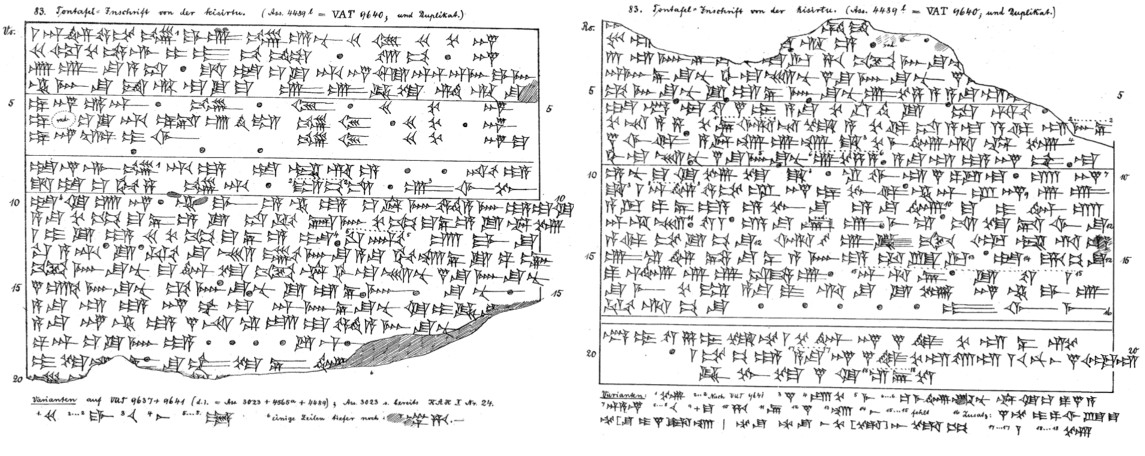
VAT 09640 (Ass 044891). Schroeder, KAH 2 no. 83
This is the earliest known edition of Adad-nerari II's annals. It
has been retrieved on two clay tablet fragments at Ashur (great
courtyard of the Aššur temple), and it bears the eponym date of
Šeʾi-Aššur (909 BC; second eponym of the Assyrian
Eponym List [/saao/corpus/Q004243/] and third year of Adad-nerari's reign). The
text is partly broken in the part dedicated to the military campaigns
– only the first campaigns are fully preserved – whereas the building
section, where the ruler says to have rebuilt the wall facing "at the
entrance of the city beneath the Aššur temple," is preserved. The
ruler states here to have renovated a work originally of his namesake
predecessor (Adad-nerari I), who we know for being responsible for
works on different facings of quay walls (kisirtu) in the
city (see, for example,
text no. 8 [/riao/ria2/adadnararii/texts119/index.html#adadnerari108]).
Interseting featrue of the colophon (ex. 1) is the presence, along
with the eponym date, of mention of the two high official of the city
Ashur in charge of the facing of the quay wall: Gabbiya-ana-Aššur,
governor of the land of Inner City, and Adad-aḫa-iddin, mayor.
Access the composite text [/riao/ria3/Q006020/] of Adad-nārārī II 01.
Bibliography
2
The longest and latest version of Adad-nerari II's annals is preserved on a relatively complete tablet from Ashur, and in other three fragmentary exemplars that have made some restorations possible. Ex. 2 (VAT 9632), however, has been here edited according to Grayson, as text no. 3, while another very similar text (VAT 09630) is edited as no. 4.
The tablet is itself dated to the year of Ilī-napištī-uṣur, (893 BC), Adad-nderari's nineteenth regnal year. The text opens with an invocation to the gods and with royal names and epithets (ll. 1-22). The annalistic section of the inscription starts with a summary of earlier campaigns (ll. 23-35) followed by a description of the reconstruction works led at the city Apqu (ll. 36-38), which Grayson suggests being originally a display inscription composed for Apqu and copied here. The later campaigns, from the seventh to the eighteenth regnal year, are then described (39-104) with more details than in the first section; ll. 105-119 show the first example of "show of strength" expedition that will be later encountered also in the inscriptions of Tukulti-Ninurta II and Ashurnasirpal II.
ll. 120-121 are dedicated to the improvement of the land, an ideological theme not always present in royal inscription, while the next seven lines have a passage about hunting. The building section concerns the restoration of the Gula temple at Ashur. The inscription ends with blessing, curses and date.
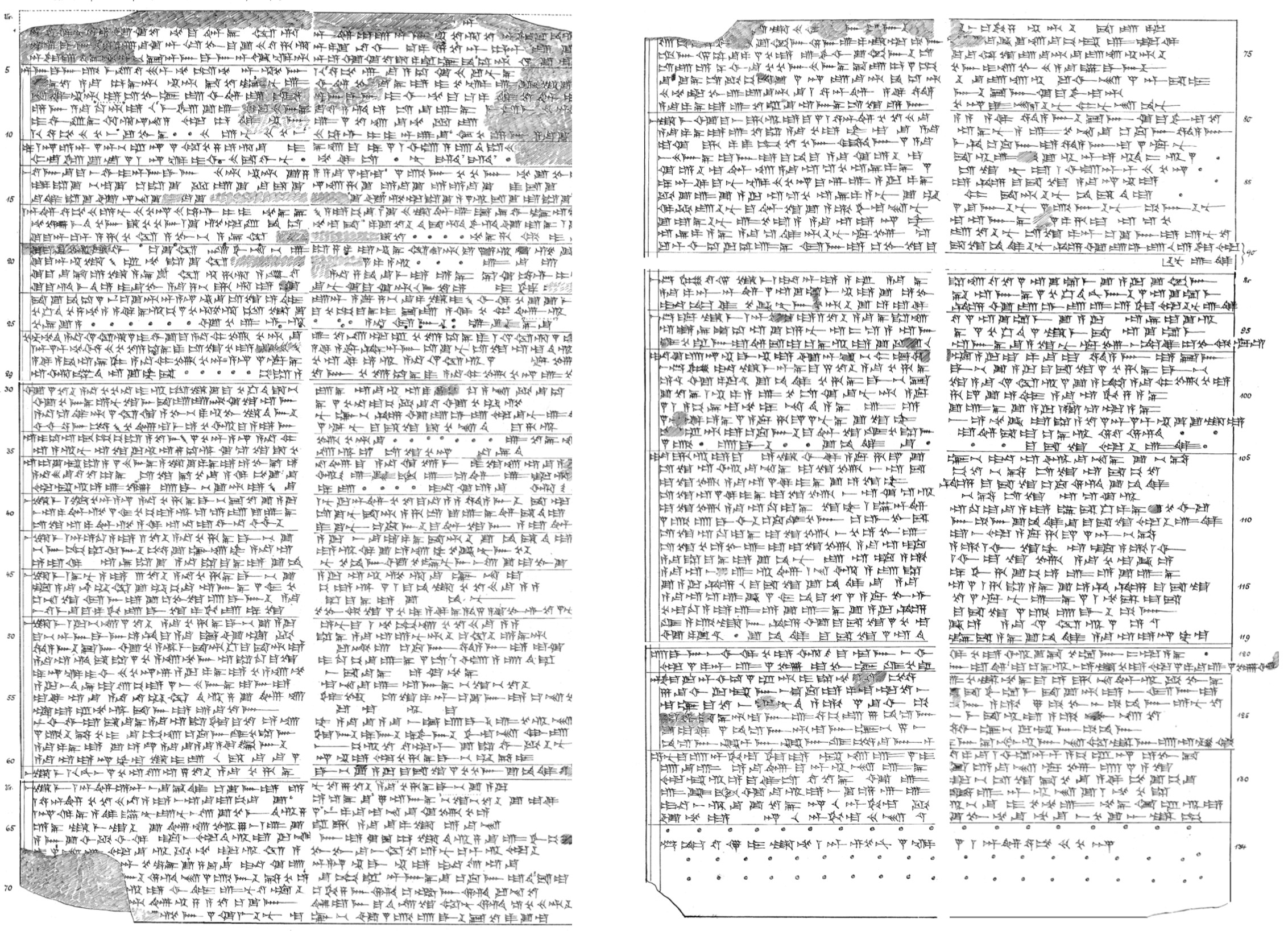
VAT 08288 (Ass 18497). Schroeder, KAH 2 no. 84
Access the composite text [/riao/ria3/Q006021/] of Adad-nārārī II 02.
Bibliography
3
This fragment of a clay tablet was found in Ashur and it seems to bear a text strongly resembles text no. 2, although it differs from it in the building section.
Access the composite text [/riao/ria3/Q006022/] of Adad-nārārī II 03.
Bibliography
4
This edition includes two fragmentary texts, which correspond to two exemplars of the same annals as far as they are readable, but that already in teh edition of Grayson (RIMA 2 pp. 156-159) have been divided in two separate entries. The content of the annalistic part is similar but not identical with text no. 2, as it comprises records from the seventh campaign to Ḫanigalbat and, especially in the first part of the text, it has duplicate passages, but also presents substantial differences. Differences with text no. 2 are evident in the record of the campaign against Lullumu and others, more detailed (obv. 17'b-20') and the narrative on the campaigns against Katmuḫu and other regions (obv. 21'-26'). The building section is lost.
Access the composite text [/riao/ria3/Q006023/] of Adad-nārārī II 04.
Bibliography
5
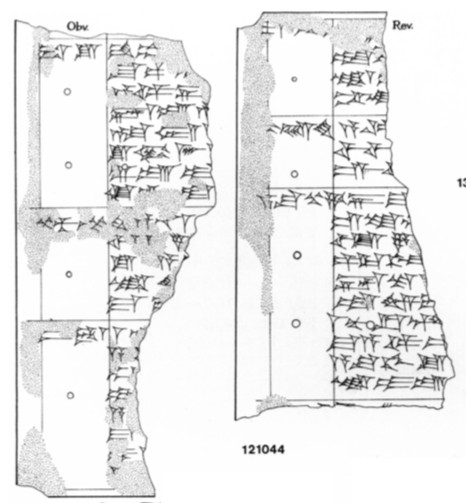
BM 121044. Millard, Iraq 32 pl. XXXVI
A fragment of clay tablet found at Nineveh bears a copy of Adad-nārārī II's annals. The preserved portion of the inscription is identical to the annals found at Ashur (see text no. 4 [/riao/ria3/Q006023/]). The provenance of the text, however, implies that the building description would have been substantially different.
Access the composite text [/riao/ria3/Q006024/] of Adad-nārārī II 05.
Bibliography
6
This text is inscribed on a stone fragment (possibly a vase) that was discovered in the palace of Adad-nārārī at Ashur. The present location of the object is unknown.
Access the composite text [/riao/ria3/Q006025/] of Adad-nārārī II 06.
Bibliography
7
This short text is inscribed on two stone cylinders and numerous stone slabs found at Nineveh. They are all bear the exact same inscription, exception for those written on the cylinders, which contain some minor variations. One of the slabs was discovered at Babylon. There are two possible explanations for this: it may be evidence of prolific building work on the part of Adad-nārārī II or the object may have been taken to Babylon as booty after the fall of Nineveh in 612 BC. The second is the more plausible of the two explanations.
Access the composite text [/riao/ria3/Q006026/] of Adad-nārārī II 07.
Bibliography
8
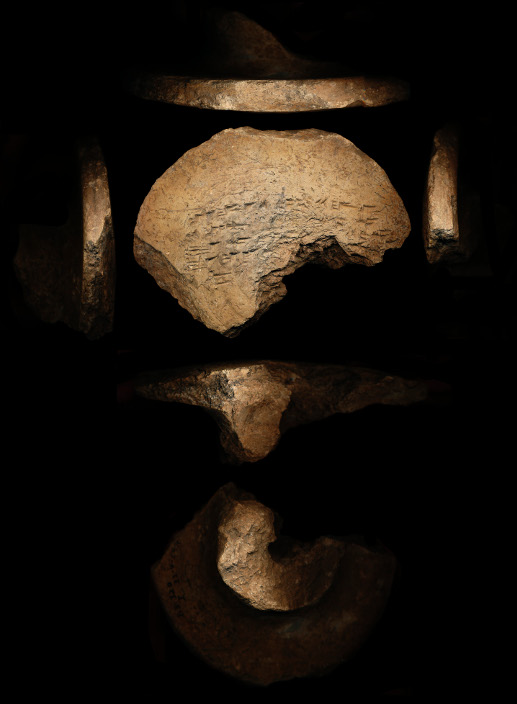
UM 33-04-144
This text is written on a clay cone found at Tell Billa (ancient Šibaniba). The object is now housed in the University Museum, Philadelphia.
Access the composite text [/riao/ria3/Q006027/] of Adad-nārārī II 08.
Bibliography
1001
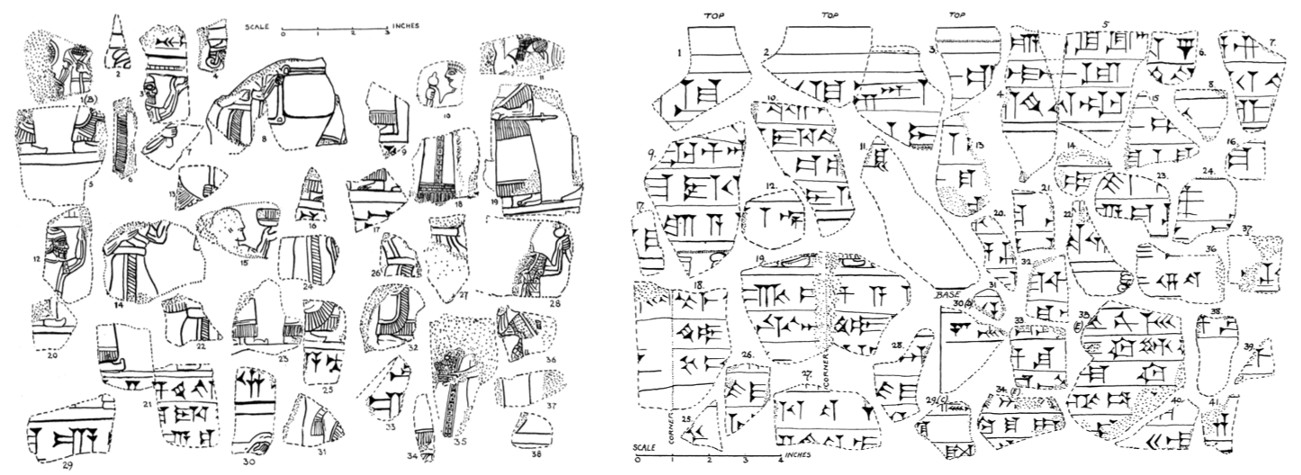
BCM 0898-037. Thompson, Iraq 4 pp. 43-46
Seventy-nine stone fragments engraved with traces of scenes in relief and inscriptions have been discovered at Nineveh by R.C. Thompson (1930-1). The scholar has recognized five different possible originals represented by the fragments (A-E, see fig. above): the greatest number (left: nos. 2-38, right: 1-28, 31-3, 36-41) belongs to group (A); (B) corresponds to a single piece (left: no. 1) of apparently finer work, but of the same fine-grained, black structureless limestone; a stone with a very different texture is the one of group (C), also one piece (right: no. 29), written in archaic style on black stone "probably of carboniferous age." (Thompson 1937:43); one piece (left: no. 30) belongs to (D), "a trifle cruder in cutting of Tertiary limestone black on exposure; finally, group (E) has also one piece (right: no. 34, possibly no. 35) of mottled, coloured Tertiary limestone, "its red colour due to iron oxides, fine grained and very compact and hard, slightly siliceous."
As for the identification of the inscriptions, the majority of them seem to belong to a single relief or, as suggested by Grayson (RIMA 2 p. 161) an obelisk similar in form to the Black or Rassam Obelisk from Nimrud of Ashurnasirpal II (text no. 24), especially considering the frequency of survived lines beginning with madattu ša... "tribute of" as typical of this kind of monumental inscriptions. Thompson ascribes the fragments to the same Ashurnasirpal, but Grayson suggests Adad-nerari II on the basis of the presence of the geographic name Meḫru (see, Adad-nerari II texts nos. 1 rev 8'; 2: 24; 4 obv. 16'; but cf. also Tiglath-pilseser I text no. 2: 30, and Ashurnasirpal II text no. 40: 28).
Access the composite text [/riao/ria3/Q006028/] of Adad-nārārī II 1001.
Bibliography
1002
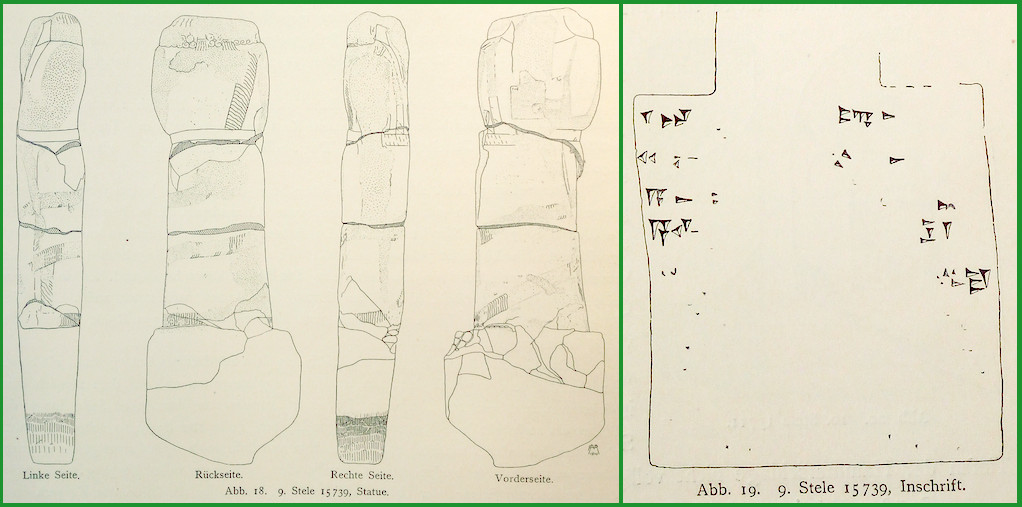
Ass 15739. Andrae, Stelenreihen pp. 14-18 and pl. XII no. 9
This is a badly preserved stele 225 cm high (originally ca. 300; Andrae, Stelenreihen p. 14) from the rows of stele in Ashur. W. Andrae, who excavated it, suggested to identify Adad-nerari II with this stele, but this is still far from certain
Access the composite text [/riao/ria3/Q006029/] of Adad-nārārī II 1002.
Bibliography
1003
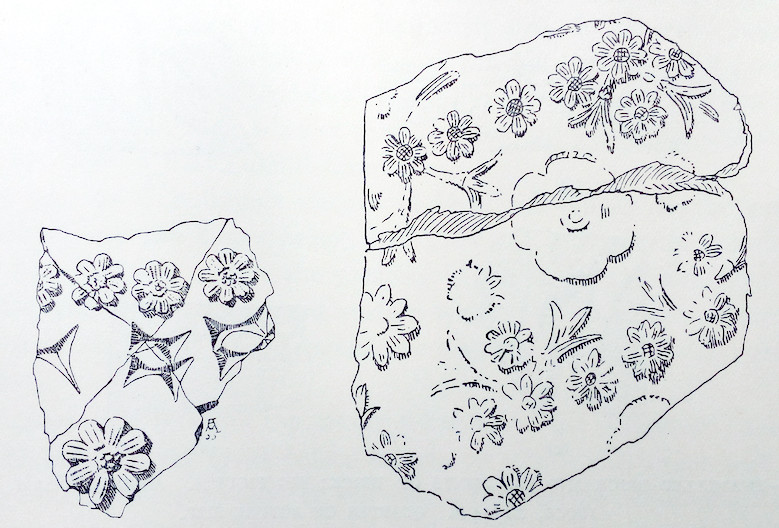
Ass 08911, Ass 18251. Andrae, Coloured Ceramics, p. 9 and fig. 1-2
A fragment of a vase with flower motives on it found at Ashur bears traces of the name of Adad-nerari.
Access the composite text [/riao/ria3/Q006030/] of Adad-nārārī II 1003.
Bibliography
Nathan Morello & Poppy Tushingham
Nathan Morello & Poppy Tushingham, 'Inscriptions', The Royal Inscriptions of Assyria online (RIAo) Project, The RIAo Project, a sub-project of MOCCI, 2023 [http://oracc.museum.upenn.edu/riao/thekingdomofassyria1114884bc/adadnarariii/inscriptions/]